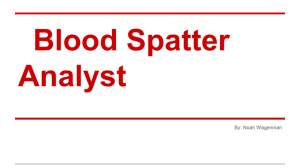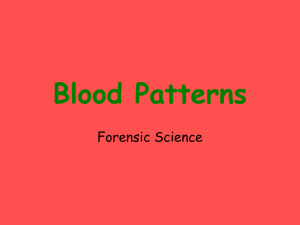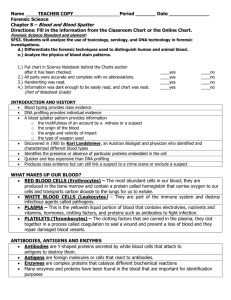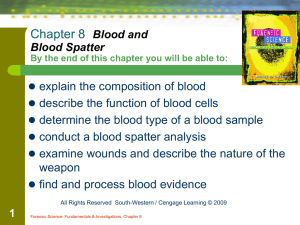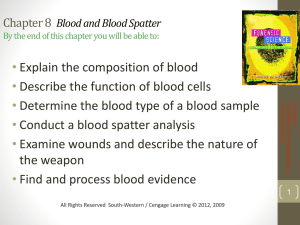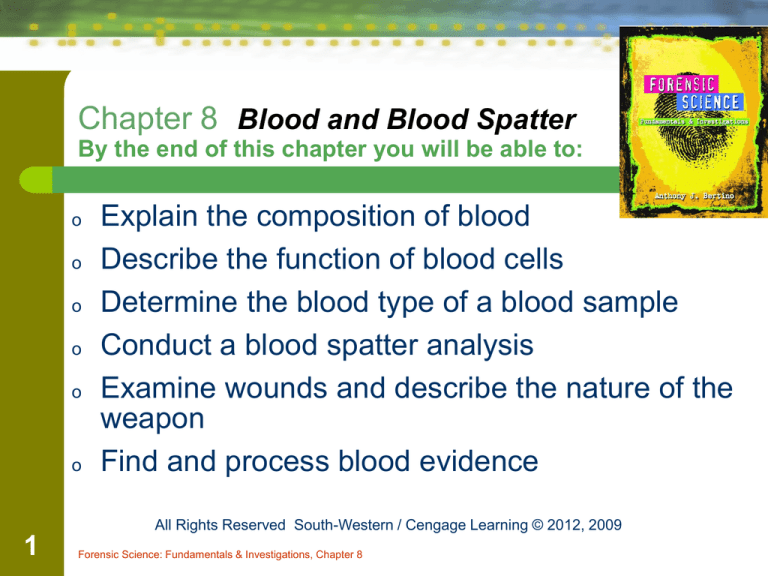
Chapter 8 Blood and Blood Spatter
By the end of this chapter you will be able to:
o
o
o
o
o
o
Explain the composition of blood
Describe the function of blood cells
Determine the blood type of a blood sample
Conduct a blood spatter analysis
Examine wounds and describe the nature of the
weapon
Find and process blood evidence
All Rights Reserved South-Western / Cengage Learning © 2012, 2009
1
Forensic Science: Fundamentals & Investigations, Chapter 8
Introduction and History
o
o
o
Blood typing provides class evidence
DNA profiling provides individual evidence
A blood spatter pattern provides information
•
•
•
•
2
the truthfulness of an account by a witness or a
suspect
the origin of the blood
the angle and velocity of impact
the type of weapon used
Forensic Science: Fundamentals & Investigations, Chapter 8
Composition of Blood
o
o
o
o
3
Plasma—a liquid suspending other blood
components
Red blood cells (Erythrocytes)—carries oxygen
to the body’s cells and carbon dioxide away
White blood cells (Leukocytes)—fights disease
and foreign invaders and, alone, contain cell nuclei
Platelets—aids in blood clotting and the repair of
damaged blood vessels
Forensic Science: Fundamentals & Investigations, Chapter 8
o
4
55% Plasma
• 92% of plasma is made
up of water
• 8% are other substances
such as ions, hormones,
glucose
45% Formed Elements
• 99 % of F. E. are red
blood cells (RBC’s)
• 1% called the buffy coat
are white blood cells
(immunity) and platelets
(clotting)
Forensic Science: Fundamentals & Investigations, Chapter 8
Composition of Blood
5
Forensic Science: Fundamentals & Investigations, Chapter 8
Types of White Blood Cells
6
Forensic Science: Fundamentals & Investigations, Chapter 8
Blood Typing—Proteins
o
o
o
o
7
Discovered in 1900 by Karl Landsteiner
Identifies the presence or absence of particular
proteins embedded in the cell
Quicker and less expensive than DNA profiling
Produces class evidence but can still link a
suspect to a crime scene or exclude a suspect
Forensic Science: Fundamentals & Investigations, Chapter 8
Blood Typing—Antibodies
Antigens are proteins on the surface
of some RBC’s that
react to antibodies
Two types: A antigens & B
antigens
o
8
Antibodies are Y-shaped
proteins secreted by white
blood cells that attach to
antigens to destroy them.
•
2 types: Anti-A (fights A antigens)
and Anti-B (fights B antigens)
Forensic Science: Fundamentals & Investigations, Chapter 8
Blood Typing—Proteins
antigens
42%
9
12%
3%
of the population in the United States
Forensic Science: Fundamentals & Investigations, Chapter 8
43%
Which is the rarest blood type?
o
10
http://www.redcrossblood.org/learn-aboutblood/blood-types
Forensic Science: Fundamentals & Investigations, Chapter 8
blood types
There are 4 major blood types: A, B, AB, & O. Our
blood plasma produces _____________against blood that
is not our own, except for the ________blood type.
BLOOD
TYPE
ANTIGEN
ANTIBODIES
PRODUCED
CAN
DONATE
TO
CAN
RECEIVE
FROM
ABO AGGLUTINATION
(CLUMPING)
ANTI-A
ANTI-B
WELL
PLATES
A
B
%
Rh Factor
85% of the population has a protein called
RH factor on their blood cells
13
Forensic Science: Fundamentals & Investigations, Chapter 8
Blood Enzymes
o
o
14
Enzymes are complex proteins that catalyze
different biochemical reactions
Many enzymes and proteins have been found in
the blood that are important for identification
purposes
Forensic Science: Fundamentals & Investigations, Chapter 8
Blood Typing
—Probability and Blood Types
o
o
The probability of a blood type equals the product of
probabilities for each protein group
If Type A = 42% and Rh Factor = 85%
Then A+ = .42 x .85 = .357 (35.7%)
Knowing additional proteins and enzymes in the
blood sample
•
•
15
Narrows the population group
Increases the probability of identifying a suspect
Forensic Science: Fundamentals & Investigations, Chapter 8
Blood Spatter
o
o
o
o
o
16
http://www.youtube.com/watch?v=Od8YuwUT
794 Las Vegas real blood spatter experts
1939—spatter patterns first
analyzed
Blood may spatter when a wound is inflicted
Blood spatter pattern—a grouping of blood
stains
Patterns help to reconstruct the events
surrounding a shooting, stabbing, or beating
Forensic Science: Fundamentals & Investigations, Chapter 8
Blood Spatter Analysis
Analysis of a spatter pattern can aid in
determining the:
17
•
direction blood traveled
•
angle of impact
•
point of origin of the blood
•
velocity of the blood
•
manner of death
Forensic Science: Fundamentals & Investigations, Chapter 8
Blood Spatter Analysis
Natural cohesiveness of blood
http://www.youtube.com/watch?v=qX7Fd_QNX
Ys
18
Forensic Science: Fundamentals & Investigations, Chapter 8
Blood Spatter Analysis
o
Satellite droplets—
• When blood falls from a height, or at a high velocity,
• It overcomes its natural cohesiveness, and
• Separates from the main droplet
o
Spiking patterns—
• Form around the droplet
edges when blood falls
onto a less-than-smooth
surface
19
Forensic Science: Fundamentals & Investigations, Chapter 8
Blood Spatter Analysis
—Directionality
The shape of an individual drop of blood
provides clues to the direction from
where the blood originated.
How will the point of impact compare
with the rest of a blood pattern?
20
Forensic Science: Fundamentals & Investigations, Chapter 8
Blood Spatter Analysis
Lines of convergence—two or blood splatters can
pinpoint the location of the blood source
21
Forensic Science: Fundamentals & Investigations, Chapter 8
Blood Spatter Analysis
—Six Patterns
Classify each of the following as passive or active,
then choose the type: arterial spray/spurt,
transfer, wipe or swipe, cast off, high velocity
impact, med/low velocity impact, walking drip,
22
Forensic Science: Fundamentals & Investigations, Chapter 8
Blood Spatter Analysis
—Impact
o
o
23
Patterns can help investigators determine
the type of weapon used
What kind of a pattern is produced by a gun
shot?
What kind of a pattern is produced by a
hammer blow?
Forensic Science: Fundamentals & Investigations, Chapter 8
Crime Scene Investigation
of Blood
1. Search for blood evidence
2. Determine
a. Is the evidence blood?
b. Is the blood human?
c. What is the blood type?
3. Interpret the findings:
a. Is the blood type consistent with a suspect’s blood?
b. If not, exclude that suspect
c. If yes, decide if DNA profiling is necessary
24
Forensic Science: Fundamentals & Investigations, Chapter 8
Blood Spatter Clips
25
o
http://www.youtube.com/watch?v=J40wqqg_
8Ww Dexter stringing
o
Stringing
o
Mark Winger Case: Reconstruction Using
Blood Spatter Evidence
Forensic Science: Fundamentals & Investigations, Chapter 8
. . . . . . . . . . . . . . . . . Summary
o
o
o
o
26
Blood consists of cellular components and plasma.
The various human blood types are caused by the
presence or absence of A and/or B proteins on the
surface of red blood cells.
Blood spatter evidence can be used to recreate a
crime scene.
Investigators endeavor to (a) locate, (b) identify,
and (c) interpret blood spatter patterns at crime
scenes.
Forensic Science: Fundamentals & Investigations, Chapter 8

